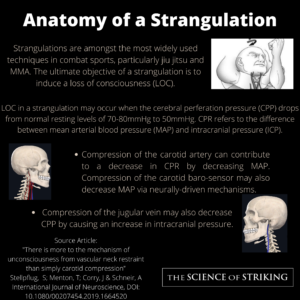BACKGROUND
Vascular neck restraint (VNR) is a common method of both submission in combat sports such as jiu jitsu and MMA, as well as a controversial restraint technique used by law enforcement officers. The ultimate objective with VNR is to induce a loss of consciousness (LOC). The common understanding in terms of mechanism of LOC is that the internal branches of the carotid arteries on each side are compressed, causing a decrease in blood flow to the brain. The objective of this article was to clarify some of these common misconceptions and add some other potential theories.
FINDINGS
Cerebral perfusion pressure (CPP) refers to the net pressure gradient causing blood flow to the brain, and is essentially the difference between the mean arterial blood pressure (MAP) and the intracranial pressure (ICP). The CPP typically sits around 70-90 mmHg, and a loss of consciousness may occur if the CPP drops below 50mmHg. A lowering of the CCP may occur due to an increase in the ICP or a decrease in the MAP.
Optimal application of a VNR involves compression to the neck on both sides, which compresses both the jugular veins (raising ICP) and carotid arteries (decreasing MAP). The jugular veins are more easily compressed than the carotid arteries due to the weakness of the vascular walls. It has been shown (outside of literature pertaining to VNR) that jugular compression induces a change in ICP.
It is also thought that compression of the carotid baro-sensor (a type of mechanoreceptor that senses change in blood vessels) may contribute to a vagally-induced decrease in MAP, and that this may alone have the potential to cause a loss of consciousness.
IMPLICATIONS
Having a greater understanding of the anatomy and physiology of choke and strangulation mechanisms may increase the safeness of their practice in both combat spokes and law enforcement environments. Understanding the specific mechanical aims of application of these techniques may also help optimise technical performance.
